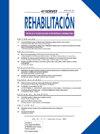全髋关节置换术后腰痛:长期回顾性队列研究
IF 0.4
Q3 Medicine
引用次数: 0
摘要
前言和目的全髋关节置换术(THA)可有效治疗髋关节骨关节炎,但术后腰痛(LBP)是已知的并发症。虽然先前的研究报告了短期下腰痛的缓解,但没有下腰痛的患者的长期结果和发病率仍不清楚。本研究旨在确定tha后腰痛的长期累积患病率。材料与方法对2010-2020年在萨拉戈萨Lozano Blesa大学临床医院接受髋关节置换术治疗的476例患者进行纵向回顾性队列研究。分析术前和术后腰痛(腰痛≥7天)、社会人口统计学、临床和术后变量。采用了严格的排除标准。该研究已获得CEICA批准(cpp - ci - pi21 /346),并在ClinicalTrials.gov注册(NCT05647629)。结果476例患者(平均年龄:60.11±8岁;平均随访时间:7年),确定了4种临床轨迹:202例(42.43%)术前/术后无LBP, 97例(20.37%)术前/术后无LBP (P = 0.002), 128例(26.89%)术前/术后均有LBP (P <;0.001),术前无术后无腰痛的49例(10.29%)。总体而言,47.26% (n = 225)的患者出现了术后腰痛。BMI与BMI之间呈弱相关(R = 0.16;P = 0.040)和权重(R = 0.22;P = 0.004)术前有LBP的患者中,年龄和性别无差异。结论术后LBP长期发生率为47.26%(持续发生率为26.89%,新发发生率为20.38%)。BMI和体重是适度的相关因素。手术影响的异质性突出了前瞻性研究以优化管理的必要性。本文章由计算机程序翻译,如有差异,请以英文原文为准。
Low back pain after total hip arthroplasty: Long-term retrospective cohort study
Introduction and objective
Total hip arthroplasty (THA) effectively treats hip osteoarthritis, but postoperative low back pain (LBP) is a known complication. While prior studies report short-term LBP resolution, long-term outcomes and incidence in patients without prior LBP remain unclear. This study aims to determine the long-term cumulative prevalence of LBP post-THA.
Material and methods
A longitudinal retrospective cohort study was conducted on 476 patients undergoing THA for coxarthrosis at Lozano Blesa University Clinical Hospital of Zaragoza (2010–2020). Pre- and postoperative LBP (lumbar pain ≥7 days) and sociodemographic, clinical, and postsurgical variables were analyzed. Strict exclusion criteria were applied. The study was approved by the CEICA (C.P.-C.I.-PI21/346) and registered at ClinicalTrials.gov (NCT05647629).
Results
Among 476 patients (mean age: 60.11 ± 8 years; mean follow-up: 7 years), four clinical trajectories were identified: 202 (42.43%) without pre/postoperative LBP, 97 (20.37%) without preoperative but with postoperative LBP (P = 0.002), 128 (26.89%) with pre- and postoperative LBP (P < 0.001), and 49 (10.29%) with preoperative but without postoperative LBP. Overall, 47.26% (n = 225) experienced postoperative LBP. Weak correlations were observed between BMI (R = 0.16; P = 0.040) and weight (R = 0.22; P = 0.004) with LBP in patients with preoperative LBP, with no differences in age or sex.
Conclusions
Post-THA LBP affects 47.26% of patients long-term (26.89% persistent, 20.38% new onset). BMI and weight are modest associated factors. The heterogeneity of surgical impact highlights the need for prospective studies to optimize management.
求助全文
通过发布文献求助,成功后即可免费获取论文全文。
去求助
来源期刊

Rehabilitacion
Medicine-Rehabilitation
CiteScore
0.80
自引率
0.00%
发文量
63
期刊介绍:
La revista que es desde hace más de 40 años la publicación oficial de la Sociedad Española de Rehabilitación y referente de la mayoría de las Sociedades de la Especialidad de los países americanos de habla hispana. Se publican 5 números pluritemáticos al año y uno monográfico sobre un tema del mayor interés y actualidad designado por el consejo de redacción.
 求助内容:
求助内容: 应助结果提醒方式:
应助结果提醒方式:


